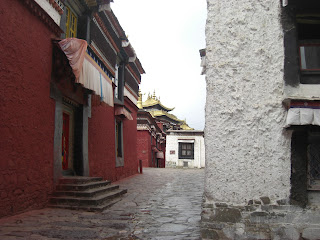Shigatse
We left Lhasa in the rain. We were heading towards Shigatse, Tibet's second largest city which lies at an altitude of 3,780 metres. It used to be a six hour journey but with the recent opening of a dual carriage way just weeks before between the two cities with long tunnels, viaducts and gentle curves and gradients, the time has been cut to under four hours.
We stopped and filled up at the last petrol station before joining the new road. The old road still exists and follows a winding route along the valley floor. The new road cuts across the valley side further up the slope and away from houses and agriculture.
At another place, looking over to the other side of the valley was a tributary valley joining the main valley. It was obviously an important valley as ther were long strings of prayer flags draped across the entrance and on the sides of the entrance.
Ther were several long tunnels on the route. The longest is 15 kilometres and the second longest is 11 kilometres. A lot of the road around the highest point, the pass is in tunnels. Some are so close together that there is only 50 metres between the exit of one tunnel and the entrance to the next. This was done on purpose as it gave the engineers the opportunity to dig the tunnels from both ends at the same time although manouvring machinery and disposing of waste in such a narrow space requires planning and patience.
The narrow space was also often in a steep river valley with steep sides. The road bed needed to be protected from falling rocks and avalanches in winter. This resulted in a bridge over a river in a steep sided valley to connect the two tunnel entrances which had to be protected with a steel girder case and thick wite netting.
Some of the rock and snow avalanche protection of a bridge between two tunnels.
A railway also followed the same route up the valley. It had been upgraded and a alrge proportion of the track was either in tunnels or viaducts. Very little of the rail bed was on the natural ground without cuttings or embankments leading up to the next tunnel or viaduct.
Looking across the dual carriage way at a viaduct buit for the train. Despite running along side each other for four hours, we never saw a train on the tracks.
Some of the rock and snow avalanche protection of a bridge between two tunnels.
A railway also followed the same route up the valley. It had been upgraded and a alrge proportion of the track was either in tunnels or viaducts. Very little of the rail bed was on the natural ground without cuttings or embankments leading up to the next tunnel or viaduct.
Looking across the dual carriage way at a viaduct buit for the train. Despite running along side each other for four hours, we never saw a train on the tracks.
Our driver needed a break. He couldn't drive for more than four hours without a 20 minute break. We stopped at a motorway service station. There was a large car park and a huge truck park. The planners, designers and builders must have been pleased with themselves for finishing the road building ahead of schedule.
The issue was that the rest of the infrastructure had not yet been completed. There were several buildings on site complete with fascias but had not yet had interior works carried out and their doors were locked. Peering through the glass of locked doors, the supermarket had no shelves. The petrol station had no petrol and the hotel had no welcoming lobby or reception area. We were only too happy to move on after our driver had finished his enforced 20 minute break.
We had gone through the Gampala Pass with an elevation of 4,790 metres. Actually we had gone underneath the pass. The improved road had so many tunnels and viaducts that shortened the route and cut out steep gradients that traffic had to crawl through and negotiate hairpin bends that we had peaked dozens of metres below the quoted height of the pass.
We were soon running alongside a river. The photos were taken through the window of the door. The red characters as seen as if through a mirror read 'Exit'.
We had a Tibetan style lunch with Neplese or Chinese options then went to our hotel to drop our bags. Then we picked up our permits to visit Everest Base Camp from a local police station and stopped off at the Tashilunpo Monastery. It is the traditional mnastic seat of the Panchen Lama. The Panchen Lama is one of the most important figures in the Gelug tradition, with the spiritual authority second only to the Dalai Lama. Together with the council of high lamas, he is in charge of seeking out the next Dalai Lama.
The entrance to the complex. It is the largest monastery in Tibet and houses over a thousand monks. It was founded in 1447 by the 1st Dalai Lama.
The courtyard behind the entrance gate.
There is so much to say but I will reserve that for the book. Just now, I will let you see some of the buildings and stunning and intriate decoration that you could see if you visited it yourself.
There is so much to say but I will reserve that for the book. Just now, I will let you see some of the buildings and stunning and intriate decoration that you could see if you visited it yourself.
























No comments:
Post a Comment